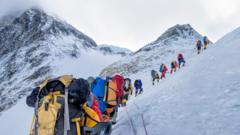In a significant policy shift, Nepal has increased the climbing permit fees for Mount Everest for the first time in nearly ten years. From September, climbers will now pay $15,000 (£12,180) to attempt a summit during the peak climbing season from April to May, marking a substantial 36% increase from the previous fee of $11,000. Additionally, those aspiring to climb outside peak season will also face similar percentage hikes; fees will rise to $7,500 from September to November and $3,750 during the winter months of December to February.
The government views these fees as vital to its revenue stream, with mountain tourism contributing over 4% to the nation's economy. Nepal's Department of Tourism Director General, Narayan Prasad Regmi, emphasized the need to update the old fee structure, stating, "The royalty (permit fees) had not been reviewed for a long time. We have updated them now." However, he did not elaborate on how the increased funds would be allocated.
Concerns about overcrowding on Everest have been persistent, with reports indicating that around 300 climbing permits have been issued annually. The Supreme Court of Nepal had previously mandated in April 2024 that the government must regulate the number of permits, underscoring the need to respect the environmental capacity of the majestic peaks.
In response to the overcrowding and environmental degradation, the Nepalese army commenced an annual clean-up initiative in 2019, which has reportedly removed 119 tonnes of waste, along with 14 human remains and additional skeletons. Nevertheless, it's estimated that around 200 bodies still remain on the mountain, indicating the ongoing challenges faced by Everest.
As Mount Everest and the broader Himalayan region continue to attract climbers from around the world, this permit fee increase raises questions about its potential effectiveness in managing the flow of adventurers while balancing the economic benefits of climbing tourism and environmental preservation.





















